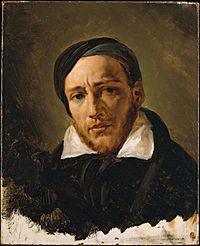Théodore Géricault facts for kids
Quick facts for kids
Théodore Géricault
|
|
|---|---|

Théodore Géricault by Horace Vernet, circa 1822–1823
|
|
| Born | 26 September 1791 |
| Died | 26 January 1824 (aged 32) Paris, France
|
| Nationality | French |
| Known for | Painting, lithography |
|
Notable work
|
The Raft of the Medusa |
| Movement | Romanticism |
Jean-Louis André Théodore Géricault (26 September 1791 – 26 January 1824) was a French painter and lithographer. He is most famous for his painting The Raft of the Medusa. Even though he died young, Géricault was one of the first artists to create the Romantic art movement.
Contents
Early Life and Art Training
Théodore Géricault was born in Rouen, France. He learned about art from different teachers. One teacher, Carle Vernet, taught him about English art that showed sports and animals. Another teacher, Pierre-Narcisse Guérin, taught him how to draw people in a classical style. Guérin thought Géricault was very talented, but also a bit wild.
Géricault soon left the classroom. He chose to study art at the Louvre Museum from 1810 to 1815. There, he copied paintings by famous artists like Rubens, Titian, Velázquez, and Rembrandt.
While at the Louvre, he found a lively energy in these older paintings. He felt this energy was missing from the popular art style of his time, called Neoclassicism. Géricault also spent a lot of time in Versailles. He was able to visit the palace stables, where he learned a lot about the bodies and movements of horses.
Becoming a Successful Artist
Géricault's first important painting was The Charging Chasseur. He showed it at the Paris Salon in 1812. This painting showed how Rubens's style influenced him. It also showed his interest in painting modern topics. This early success was a big achievement for him.
After this, Géricault changed his focus for a few years. He made many small studies of horses and soldiers on horseback.
He showed another painting, Wounded Cuirassier, at the Salon in 1814. This painting was not as popular. Géricault was disappointed and joined the army for a short time in Versailles. For almost two years after the 1814 Salon, he studied how to draw figures and arrange them in paintings. He always liked to show strong feelings and drama in his art.
Géricault traveled to Florence, Rome, and Naples in Italy from 1816 to 1817. This trip made him very interested in the artist Michelangelo. Rome inspired him to plan a huge painting called the Race of the Barberi Horses. This painting was meant to be very grand and unique. However, Géricault never finished it and returned to France.
The Raft of the Medusa
Géricault often returned to painting military scenes. The lithographs he made about soldiers after his trip to Italy are considered some of the first great works in that art form. His most important and ambitious painting is The Raft of the Medusa (1818–19). This painting showed what happened after a French ship, the Meduse, sank. The ship's captain had left the crew and passengers to die.
This event became a huge national scandal in France. Géricault's powerful painting showed this real-life tragedy on a very large scale. The painting became famous because it criticized the government and its leaders. But it also showed a timeless idea: people's struggle against nature. The young artist Eugène Delacroix was very impressed by it and even posed for one of the dying figures in the painting.
The way the people are drawn and how the painting is put together looks classical. But the subject itself is very dramatic. This mix makes the painting an important link between Neoclassicism and romanticism. It combines ideas from many artists, like Michelangelo's Last Judgment, Antoine-Jean Gros's way of showing big current events, and Henry Fuseli's groups of figures. It might also have been inspired by Watson and the Shark by John Singleton Copley.
When the painting was first shown at the Paris Salon in 1819, it caused a lot of discussion about politics. Then, in 1820, it traveled to England with Géricault, where it received much praise.
While in London, Géricault saw many people living in poverty. He made drawings of what he saw and published lithographs based on these observations. These works showed real life without being overly emotional. He spent a lot of time with Charlet, who was a lithographer and cartoonist. In 1821, while still in England, Géricault painted The Derby of Epsom.
Later Life and Final Works
After returning to France in 1821, Géricault was inspired to paint a series of ten portraits. These were portraits of patients of his friend, Dr. Étienne-Jean Georget, who was a pioneer in mental health care. Each portrait showed a person with a different emotional or mental health challenge. Five of these portraits still exist today, including Insane Woman.
These paintings are known for their strong style, realistic way of showing feelings, and for capturing the inner struggles of people.
Géricault's last projects were early drawings for several large paintings. These included the Opening of the Doors of the Spanish Inquisition and the African Slave Trade. These drawings show that he had big plans, but Géricault's health got worse. He was weakened by accidents from riding horses and a long-term illness called tuberculosis. Théodore Géricault died in Paris in 1824 after a period of suffering. His tomb at Père Lachaise Cemetery in Paris has a bronze statue of him lying down with a brush in his hand. Below it is a carving of The Raft of the Medusa.
Works
-
Riderless Racers in Rome, 1817 (The Walters Art Museum)
Portraits of People with Special Conditions
-
The Woman with a Gambling Mania, 1822 (Louvre, Paris)
-
Man Suffering from Delusions of Military Rank, 1822 (Collection Oskar Reinhart am Römerholz, Winterthur)
-
A kidnapper, 1822–1823 (Museum of Fine Arts, Springfield, Massachusetts)
-
The Melancholic Man, [Unknown Year], (Ravenna, Emilia-Romagna, Italy)
See also
 In Spanish: Théodore Géricault para niños
In Spanish: Théodore Géricault para niños




















